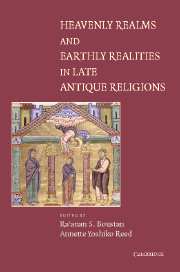Book contents
- Frontmatter
- Contents
- Preface
- List of Contributors
- Introduction: “In Heaven as It Is on Earth”
- PART ONE BETWEEN EARTH AND HEAVEN
- PART TWO INSTITUTIONALIZING HEAVEN
- PART THREE TRADITION AND INNOVATION
- 11 Angels in the Architecture: Temple Art and the Poetics of Praise in the Songs of the Sabbath Sacrifice
- 12 The Collapse of Celestial and Chthonic Realms in a Late Antique “Apollonian Invocation” (PGM I 262–347)
- 13 In Heaven as It Is in Hell: The Cosmology of Seder Rabbah di-Bereshit
- 14 The Faces of the Moon: Cosmology, Genesis, and the Mithras Liturgy
- 15 “O Paradoxical Fusion!”: Gregory of Nazianzus on Baptism and Cosmology (Orations 38–40)
- Select Bibliography
- Index
11 - Angels in the Architecture: Temple Art and the Poetics of Praise in the Songs of the Sabbath Sacrifice
Published online by Cambridge University Press: 14 July 2009
- Frontmatter
- Contents
- Preface
- List of Contributors
- Introduction: “In Heaven as It Is on Earth”
- PART ONE BETWEEN EARTH AND HEAVEN
- PART TWO INSTITUTIONALIZING HEAVEN
- PART THREE TRADITION AND INNOVATION
- 11 Angels in the Architecture: Temple Art and the Poetics of Praise in the Songs of the Sabbath Sacrifice
- 12 The Collapse of Celestial and Chthonic Realms in a Late Antique “Apollonian Invocation” (PGM I 262–347)
- 13 In Heaven as It Is in Hell: The Cosmology of Seder Rabbah di-Bereshit
- 14 The Faces of the Moon: Cosmology, Genesis, and the Mithras Liturgy
- 15 “O Paradoxical Fusion!”: Gregory of Nazianzus on Baptism and Cosmology (Orations 38–40)
- Select Bibliography
- Index
Summary
Since the first partial publication of the Songs of the Sabbath Sacrifice (henceforth, the Songs) forty years ago, scholars have explained the cycle's repetitious and sonorous language as a device intended to induce intensified states of “religious” feeling or consciousness. This approach views the syntactic and grammatical anomalies of the Songs – broken syntax, odd vacillations between singular and plural forms, and in particular dense participial and nominal clusters – primarily as epiphenomena of their ritual-liturgical function. Even those who have been wary of using transhistorical categories, such as “mysticism” or “mystical experience,” to account for the formal features of Songs have nonetheless resorted to functionalist explanations when confronted with the idiosyncratic poetics of the cycle, often relying on supposed phenomenological affinities between the Songs and the hymnic material found in the Hekhalot literature.
For instance, despite taking Carol Newsom to task for applying the term “mysticism” to the Songs, Johann Maier has written that “the style of the Songs is in all their parts formalistic and stereotypical and altogether results in a very solemn and overloaded diction, ceremonious and even static, less expressing thoughts or describing events than giving a numinous impression.” Maier's characterization, thus, largely recapitulates Gershom Scholem's assessment of the later Hekhalot hymns as “the non plus ultra of vacuousness,” which was itself indebted to the assertion made by the nineteenth-century scholar Philip Bloch that the hymns “do not in the least assist in the process of thought but merely reflect emotional struggle.”
- Type
- Chapter
- Information
- Heavenly Realms and Earthly Realities in Late Antique Religions , pp. 195 - 212Publisher: Cambridge University PressPrint publication year: 2004
- 2
- Cited by



